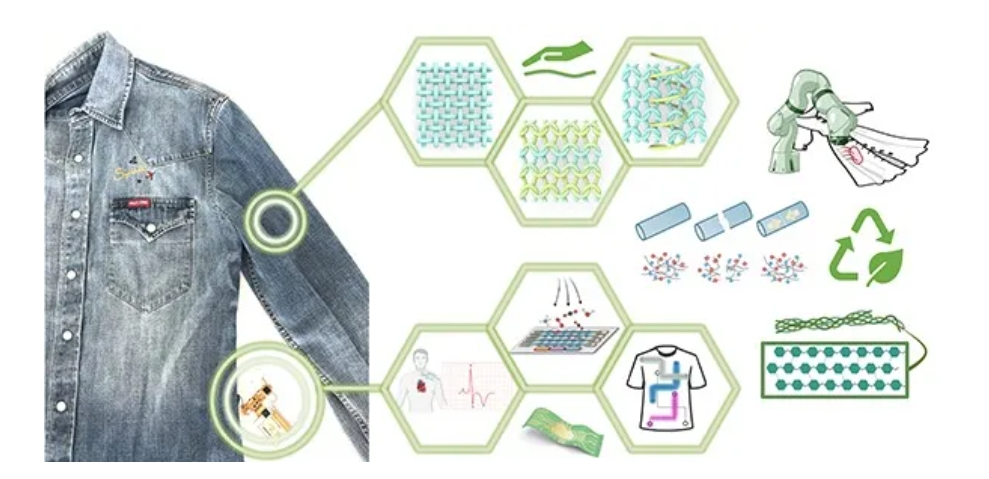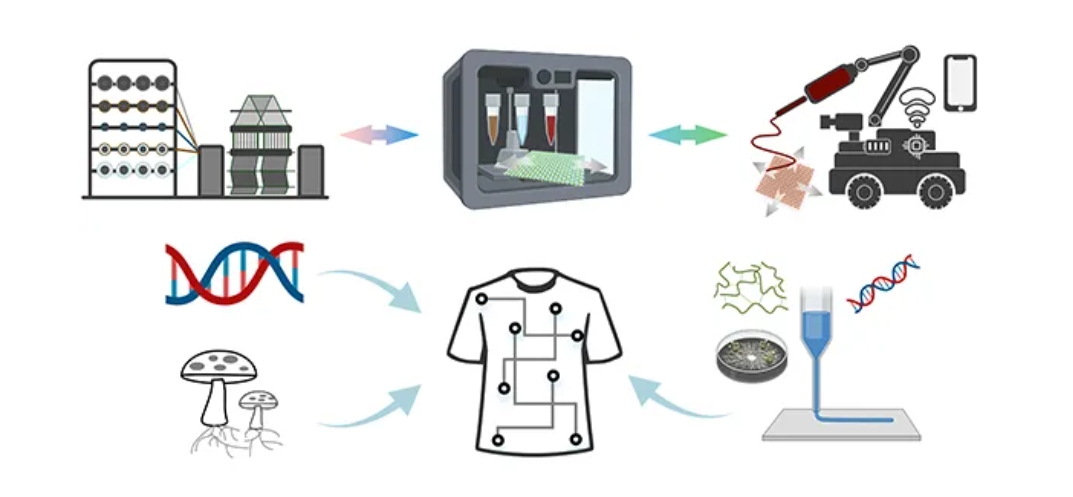Innovative wearable e-textiles fit for a sustainable circular economy
走向绿色、生物混合和循环制造的道路,要求我们将4R理念和功能性纤维生产/数字化增材制造和生物制造相结合,来生产高度定制化的电子织物设计。
——黄艳燕教授
The road towards ‘green’, biohybrid and circular fabrication calls for the marriage of our 4R concepts with functional fibre production/digital additive manufacturing and biofabrication to produce highly customisable e-textile designs.
——Prof. Shery Huang
为了让 电子织物(e-textile)有一个可持续的未来和形成规模,必须遵循4R 设计理念即“修复(Repair)、回收(Recycle)、替换(Replace)、减少(Reduce)”来进行转型,创造出符合可持续循环经济的新型可穿戴电子织物。
If electronic textiles (e-textiles) are to have a sustainable future and at scale, then a transition is needed to unlock innovative wearable e-textiles that fit a sustainable circular economy – adopting what has been termed as the 4R design concept: repair; recycle; replace; reduce.
电子织物可贴近及/或紧贴皮肤表面穿着,被用于医疗保健、游戏、运动训练和环境监测等领域。由于采用了嵌入式电子元件,电子织物可以存储和采集能量、感知、显示、驱动并进行计算。
E-textiles are worn close to and/or against the surface of the skin, with applications in healthcare, gaming, athletic training and environmental monitoring. Thanks to embedded electronic components, e-textiles can store and harvest energy, sense, display, actuate and compute.
然而,电子织物的未来发展面临两个主要挑战:
Yet there are two major challenges to the future growth of e-textiles:
首先,成本高昂,导致消费者对于电子织物的接受速度较慢;其次,大量生产带来高昂环境成本,特别是微塑料水污染。从根本上说,我们需要新的方法来防止因电子织物规模扩大而形成的下一代电子垃圾环境灾难。
Firstly, high costs, therefore resulting in slower consumer adoption. Secondly, high environmental costs associated with mass production, in particular, microplastic water pollution. Fundamentally, we need new ways to prevent the scale-up of e-textiles from becoming the next electronic waste (e-waste) environmental fiasco.
这是一个由英国、加拿大、美国和中国的工程师和科学家组成、由剑桥大学领衔的团队得出的结论。他们警告说,由于相关联的全球环境负担以及纳米材料在电子纺织品中的使用日益增多,电子纺织品供应链及其可扩展的商业化潜力可能会“进一步复杂化”。他们还提到,其中一些纳米材料会对环境构成挑战,还可能对人类健康产生不利影响(如对皮肤产生刺激或使得游离的纳米颗粒渗入皮肤)。
This is according to a team of engineers and scientists from the UK, Canada, the USA and China, led by the University of Cambridge, who warn that the e-textile supply chain and its potential for scalable commercialisation could be “further complicated” by the associated global environmental burden, and the growing use of nanomaterials in e-textiles. They say that some of these nanomaterials can pose environmental challenges and could also have adverse effects on human health (e.g. skin irritation and/or absorption of loose nanoparticles into the skin).

4R设计理念插图:修复;回收; 代替; 减少
Illustration showing the 4R design concept: repair; recycle; replace; reduce.
Credit: Dr Harvey Shi
研究团队在《自然材料》杂志上撰文,提出了 4R 电子织物设计理念,以及材料选择和生物制造启发加工方面的创新——利用增材制造工艺来生产生物材料、设备、细胞和组织的变革性方法。
Writing in the journal Nature Materials, the research team proposes the 4R e-textile design concept (repair; recycle; replace; reduce) alongside innovations in materials selection and biofabrication-inspired processing – a revolutionary approach that uses additive manufacturing processes to produce biomaterials, devices, cells and tissues.
研究的目标是实现可持续增长,并在消费者正积极地调整其购买行为与可持续发展目标一致时,平衡经济回报、可扩展商业化与“环保意识”。
The aim is to reach sustainable growth and balance economic returns/scalable commercialisation with “environmental consciousness”, at a time when consumers are actively aligning their purchasing behaviours with sustainability goals.
为使电子织物的价格更低廉、用途更广泛和供应链更完善, 4R 理念的定义如下:
The 4Rs for more affordable, versatile e-textiles products and enhanced supply chains have been defined as follows:
“纤维级”修复,如电子纤维的重新缝合、重新编织、重新编织和自我修复,以及大量 “织物级”修复,如活性材料的重新涂层、重新印刷和重新喷涂。
‘Fibre level’ repairs e.g. resewing, reweaving, reknitting and self-healing of electronic fibres, and bulk ‘fabric-level’ repairs e.g. recoating, reprinting and respraying of active materials.
最终,电子纺织材料将采用自我修复机制,使其能够随着时间的推移进行自我修复。此外,未来电子织物设计采用模块化方法,将有可能轻松更换故障部件,并使使系统的电子功能恢复活力。
Eventually, the e-textile materials would adopt self-healing mechanisms, which would give them the capability of self-repair over time. Also, with a modular approach to future e-textile designs, it is also possible to switch out faulty components easily and rejuvenate the electronic functionalities of the system.
在短期内,可通过将电子织物分类并将部件分为基础织物和电子模块来进行回收。
In the near term, recycling can be encouraged by categorising and separating e-textiles components into the base textile and the electronic modules.
基础织物可以像普通服装一样回收,而电子组件则可以像普通电子废弃物一样回收。
The base textile can be recycled as regular clothing and the electronic components recycled as regular e-waste streams.
但是,当织物中含有具有导电和传感功能的功能化电子纤维等材料时,电子织物的回收利用变得更加复杂。研究人员提到,在大多数情况下,提取既耗时又费钱,因此重新使用和再利用使用过的功能部件可能是一个可行的选择。
However, e-textile recycling becomes more complex when the fabrics contain, for example, functionalised electronic fibres with electrical conductivity and sensing capabilities. Extraction in most cases would be time-consuming and costly, say the researchers, so reusing and repurposing used functional components might be a viable option.
研究团队还指出,虽然从羊毛、丝绸、纤维素、亚麻和大麻等物质中提取的生物质纤维可以为电子织物生产提供可再生资源,但这往往不太可能。这是因为电子功能需要在纳米和微结构活性涂层和功能化策略下实现,否则这些功能就会丧失。因此,利用地球丰富元素的新型材料设计可以加速电子织物的商业化,使其对普通消费者而言更具成本效益。
The research team also notes that while biomass fibres such as those extracted from wool, silk, cellulose, flax and hemp, could provide a renewable source for e-textile production, this is not often possible. This is due to the fact that nano- and microstructured active coatings and functionalised strategies need to be applied to enable electronic functions, that would otherwise be missing. Therefore, novel materials design that utilises earth-abundant elements can accelerate e-textile commercialisation and make them more cost-effective for the average consumer.
此外,研究团队还呼吁为电子纤维封装选择替代生物衍生材料,以创造无刺激和贴肤的电子织物表面。目前,可供选择的材料大多是合成的和不可降解的。
Additionally, the research team also calls for alternative bioderived material options for electronic fibre encapsulation to create non-irritating and skin-compatible e-textile surfaces. Currently, material options are mostly synthetic and non-biodegradable.
This, according to the researchers, can be interpreted in two ways:
减少电子织物生产和应用过程中的总排放量和能耗。
Reducing the total emissions and energy consumption during e-textile production and deployment.
减少电子纺织品的用料总量,以达到和维持特定的功能。
Reducing the total amount of material used in e-textiles to achieve and maintain a specified function.
“目前,电子织物产品的可扩展商业化收到高定价以及缺乏多样性、耐用性和可洗涤性的限制。这就是为什么要从4R领域(即修复、回收、替代、减少)来考虑材料,以保障电子织物的可持续发展。”
“Currently, the scalable commercialisation of e-textiles products is limited by high pricing and lack of diversity, durability and washability,” said co-lead author Professor Shery Huang from Cambridge’s Department of Engineering. “This is why materials considerations in the 4R realm (identified as repair; recycle; replace; reduce) need to be addressed in order to secure a sustainable future for e-textiles development.”
“迄今为止,机洗电子织物加重了水流中微塑料的污染。目前面临的挑战是如何加强电子织物的功能寿命,同时尽量减少释放的微颗粒数量。解决策略包括解耦瞬态/一次性使用的部件,或者用消耗更少水的‘干洗’或‘蒸汽洗’来清洁。”
“Machine washing of e-textiles has, to date, contributed to an increase in microplastic pollution in the water stream. The challenge here is to reinforce the functional longevity of e-textiles, while minimising the number of microparticles released. Strategies for this include the decoupling of transient/single-use components or designing ‘dry’ or ‘vapour-based’ cleaning protocols that consume less water,” said co-lead author Dr Harvey Shi from Western University, Canada.
研究团队提出了各种可持续电子织物解决策略。
The research team has proposed various sustainable e-textile strategies.
例如,电子织物可分为“布面(canvas)”和“电子组件(modules)”两部分。“布面”可机洗,为用户提供大部分感官体验,而“电子组件”则是相互连接的组件,承载电子功能。
For example, an e-textile can be divided as “canvas” and “modules” components. The “canvas” is machine-washable and provides the bulk of the user’s sensory experience, while the “modules” are the interconnected components that carry electronic functionalities.
研究人员说,“布面”的设计应能在持续使用和偶尔重新配置的情况下,保持作为电绝缘和化学惰性介质的可靠性。与此同时,“模块”可以设计成易于拆卸和更换的各种形式,以便在长期使用中保持其电子功能。
The researchers say that the “canvas” should be designed to maintain reliability as an electrically insulating and chemically inert medium under persistent use and occasional reconfiguration. The “modules” meanwhile, can be designed with various formats to be easily removable and replaceable, so that their electronic functions can be maintained for long-term use.
“布面”和 “模块”可按三个初步寿命等级进行分类:第一类,准永久性—寿命约为一年;第二类,多次使用——寿命从几周到几个月不等;第三类,一次性使用。
The “canvas” and “modules” can be sorted by three preliminary lifespan ratings: quasi-permanent, with a lifespan of approximately one year; multiple use, with a lifespan ranging from weeks to months; and single-use.

展示4R 概念与功能性纤维生产、数字化增材制造和生物制造技术相结合的插图
Illustration showing the marriage of 4R concepts with functional fibre production/digital additive manufacturing and biofabrication techniques. Credit: Dr Harvey Shi.
按照研究人员的说法,4R集成电子织物的开发时间表可分为以下几个部分:
According to the researchers, the timeline for 4R-integrated e-textiles development can be broken down into the following:
近期——电子织物平台标准化,整合各种电子模块,形成创新的加工技术和工业标准,为更广泛的消费者提供便宜的电子织物。
In the near term – standardising e-textiles platforms to integrate a variety of electronic modules, leading to innovative processing technologies and industrial standardisation that will bring affordable e-textiles to a broader consumer base.
进一步的发展包括:组装流程自动化;供电子织物开发人员使用的功能性油墨形态数据库;以及建立基于使用寿命等级的组件解耦标准——此举还能有效降低电子微粒或纳米粒子在水流中的释放量。
Further developments include: automated assembly processes; a database of functional ink formations for e-textiles developers to use; and establishing standardisation in component decoupling based on longevity ratings – a move that also effectively minimises the release of electronic micro- or nanoparticles into the water stream.
剑桥大学生物介面研究小组博士生Yifei Pan说:“在近期采用这种标准化方法可以使开发者创造一个定制化的交叉兼容的功能组件;在个性化医疗和定制化非侵入性医疗市场中增强用户安全和公众利益(例如产品认证);促成指定的清洁协议。”
Yifei Pan, PhD student in the Biointerface Research Group at Cambridge, said: “Adopting this standardisation approach in the near term can enable developers to create a customised array of cross-compatible functional components; reinforce user safety and public interests in the personalised healthcare and customised non-invasive therapeutics market (i.e. product certification); and can lead to designated cleaning protocols.”
中期——采用以用户为中心的设计策略和创新的加工技术,为公众提供更多可供选择的电子织物,这些织物穿着舒适,并可根据用户需要进行个性化定制。
In the mid-term – employing user-centric design strategies and innovative processing technologies to offer a broader range of e-textiles to the public, ones that are comfortable to wear and which can be personalised to the user.
Shi博士说:“这是通过分子设计实现自愈(自我修复)纤维的关键点,无需人工干预。这将有效地创建一个可修复的电子织物生态系统,在这个系统中其产品可以轻而易举地拆卸和翻新,不会增加环境负担。”
“This is the point at which self-healing/self-repairing fibres can be achieved through molecular design and without the need for human intervention,” said Dr Shi. “This would effectively create a repairable e-textile ecosystem, in which the product can be readily disassembled and refurbished without adding to the environmental burden.”
远期——实现可持续的“有生命的”电子织物,如工程机器人皮肤。生物混合、按需纤维和生物制造技术将使这些电子织物能够自我清洁(从而最大限度地减少机洗或溶剂型清洁的要求)、自我修复,并在未来能够自我再生。
In the long term – sustainable and ‘living’ e-textiles can be realised, such as engineered robotic skin. Biohybrids, fibre-on-demand and biofabrication technologies will enable these e-textiles to self-clean (thus minimising the requirements for machine washing or solvent-based cleaning), self-repair and be capable of self-regeneration in the future.
剑桥石墨烯中心的Tawfique Hasan教授说:“总之,走向绿色、生物混合和循环制造的道路,要求我们将4R理念和功能性纤维生产/数字化增材制造和生物制造相结合,来生产高度定制化的电子织物设计。”
“In summary, the road towards ‘green’, biohybrid and circular fabrication calls for the marriage of our 4R concepts with functional fibre production/digital additive manufacturing and biofabrication to produce highly customisable e-textile designs,” said Professor Tawfique Hasan from the Cambridge Graphene Centre.
黄教授补充道:“在我们推动未来可持续电子织物制造的过程中,可能会出现一种模式转变,即从一个主要设备的集中大规模生产战略转变为更广泛的增材制造或3D打印平台,最终实现在现场就能够制造和修复电子织物。
Professor Huang added: “As we drive towards future sustainable e-textile manufacturing, there could be a paradigm shift from a centralised mass production strategy with one principal facility to a more widespread additive manufacturing/3D printing platform – ultimately creating and repairing e-textiles on-site.”

 中文
中文 English
English
